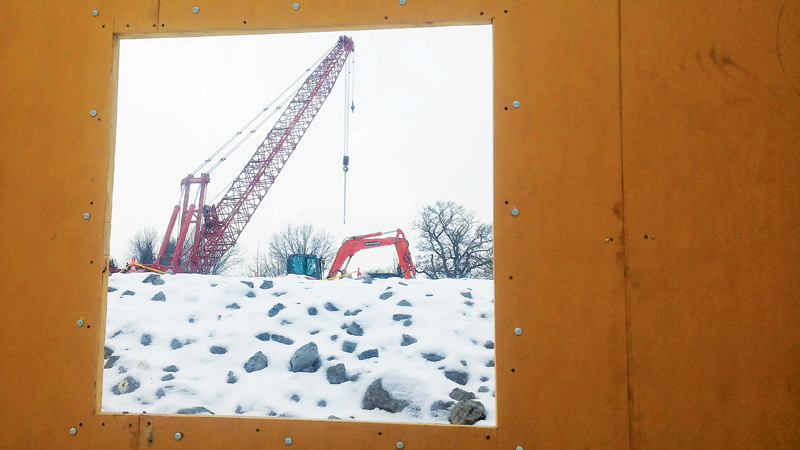DIGGING DEEP FOR A BETTER TOMORROW

In an effort to improve the water quality for the residents of Fort Wayne, Indiana the city needed to build a combined sewer overflow (CSO) system on the St. Marys and Maumee Rivers. It was faced with the need to prevent untreated sewage and wastewater from going into our rivers and flooding our neighborhoods.
Almost 300 feet underground Fort Wayne, the Three Rivers Protection and Overflow Reduction Tunnel (3RPORT) will eventually separate waste water and sewage water. When the rain falls in the future, it won’t be carrying feces and contaminated water into the rivers. It will be cleaning up nearly 90% of the overflow, creating cleaner rivers.
The Deep Rock Tunnel is the largest construction and public investment project in the City’s history. It will be built, and the public will never see it. It is hidden underground. But will benefit everyone.
Involved are world leaders in the tunnel construction business, S.A. Healy and Salini Impregilo, who have teamed up to construct Fort Wayne’s sewer transportation tunnel, according to Frank Suarez, Director of Public Information-Division of Public Works and City Utilities for the City of Fort Wayne. “These companies have a strong record of building tunnels, including projects such as the new Panama Canal.”
“We are very excited about this project. This is the fourth Combined Sewer Overflow (CSO) we are building in the USA…we look forward to working with the local workforce and the local business community and authorities,” said Giuseppe Quarta, Executive Vice President P3, Large Projects and Tunneling for The Lane Construction Corporation, and President of S.A. Healy Company.
Prep work for the site has been completed and a power sub-station is ready to go to work. There is a 65-foot diameter pump shaft and 35-foot diameter large opening called a working shaft, in place at Dwenger Avenue east of North Anthony Boulevard. The tunnel system will begin here and run east, parallel to the Maumee River, cross Swinney Park and the St. Marys River, and then continue south along the St. Marys River ending at Foster Park’s entrance.
Expecting to arrive in June, the Tunnel Boring Machine (TBM) will be assembled. After completion, the TBM will begin its job at the Dwenger Avenue site tunneling for 5 miles with its rotating cutting wheel. The machine will be removing material working 24 hours a day, 5-6 days a week, according to the City Utilities Director of Public Information. With conveyor belts, it will bring large volumes of the underground to the surface where it will be hauled away to a collection site for future use on city roads.
At the same time, the concrete tunnel lining will be constructed. The completed tunnel will have an inside diameter of 16’.
Once the tunnel is dug and the lining is in place, 7 connections called “drop shafts” will be added along the route where sewage flow drops into the tunnel. These are typically 4-8 feet in diameter.
As you drive past Foster Park, you may have noticed a large area blocked off by a yellowish-brown fence with windows. These peep-holes are for your viewing pleasure. As you walk, trek, or run the Rivergreenway stop, and take a look. View the progress being made. This tunneling project is making history world-wide and happening in your own neighborhood.
The first week of November, the site where the retrieval shaft is to be located was cleared. In December cranes and equipment moved in. Digging has begun. The 30’ retrieval hole for the work shaft will be located in this Foster Park area. The TBM has an expected date of exiting late summer or early fall of 2021.
There will also be 2 miles of relief sewer in the south end (Foster Park) area of the tunnel. This type of sewer will be constructed using the traditional “open cut” trench, where pipe is laid on the bottom. All the above ground disturbance will be restored.
The $187.7 million dollar investment is expected to be completed and operational in 2023, said Suarez. “The project will reduce the average number of combined sewer overflows going into our rivers. From 76 to 4.”
Fort Wayne’s Deep Rock Tunnel is what connects us all to better living conditions and a better community, not just for today, but for years to come. Watch for future public forums to stay informed on this project.
- ELMHURST IS COMING DOWN BUT MEMORIES REMAIN - May 25, 2018
- WAYNEDALE ELEMENTARY’S CLUB “O” PRESENTS RECITAL - May 11, 2018
- LEBAMOFF RESERVOIR PARK RESTORED - May 11, 2018


